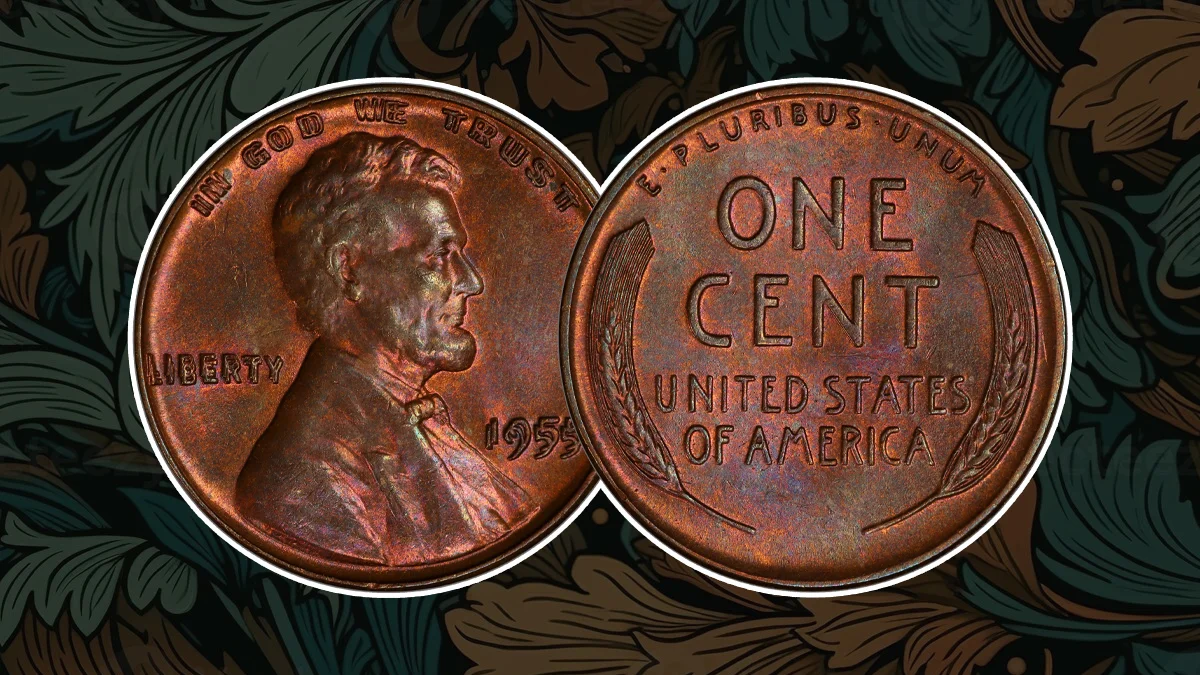
The 1955 Doubled Die Lincoln Cent, part of the Lincoln Wheat Reverse series (1909-1958), is one of the most famous error coins in U.S. numismatics. This specific variety, known as Doubled Die Obverse, was struck at the Philadelphia Mint as a Business (MS) strike. Composed of 95% copper and 5% zinc & tin, this coin is from a mintage of 330,958,200.
The 1955 Doubled Die Lincoln Cent gained legendary status due to its dramatic doubling on the obverse, which is visible in the date, “LIBERTY,” and the motto “IN GOD WE TRUST.” This error occurred serendipitously during the 1950s, a period when coin collecting was enjoying a post-war boom in popularity. Many of these coins were distributed in New England, often turning up in 23-cent cigarette packs from vending machines, which accepted only quarters.
It’s believed that more than 20,000 of these error coins were produced, though only 10,000 to 15,000 are thought to have survived. The scarcity of these coins, especially in higher grades, contributes to their value, with even well-worn examples typically commanding four-figure prices.
However, collectors should be cautious of the so-called “Poor Man’s Doubled Die,” which exhibits only minor mechanical doubling and does not carry the same value as the true 1955 Doubled Die Cent. These less valuable coins are often misrepresented as major errors, so proper authentication is crucial.
This coin’s history, rarity, and striking error make it a must-have for serious collectors, embodying a unique chapter in U.S. minting history.
History of 1955 Doubled Die Lincoln Cent
A minting error occurred at the Philadelphia Mint during the production process, giving origin to the 1955 Doubled Die Lincoln Cent. An alignment error during the rubbing process in 1955 allowed the image on the obverse dies to have doubled. The mint staff was aware of the error, but they chose not to recall the struck coins because doing so would have been to destroy a sizable batch of cents. Therefore, between 20,000 and 24,000 of these error coins have been put into use.
These coins were mainly given out in the New England region; they regularly turned up as changes in cigarette packs that had been purchased from vending machines. This surprising method of distribution added to the coin’s attraction and attracted collectors.
Specifications
- Composition: 95% Copper, 5% Zinc and Tin
- Mass: 3.11 g
- Diameter: 19.05 mm (0.750 in)
- Edge: Plain
- Mint: Philadelphia
- Mintage: Approximately 330,958,200 (total for 1955 cents), with an estimated 20,000 to 24,000 Doubled Die error coins
Design
Obverse:
The obverse side of the coin has a bust of President Abraham Lincoln. It was designed by Victor David Brenner in 1909. The doubling error is prominently visual in the date “1955,” the inscription “LIBERTY” to the left side of Lincoln’s portrait, and the motto “IN GOD WE TRUST” is written at the top side. This dramatic doubling makes the coin so recognizable and valuable.
Reverse:
The reverse side of the coin is designed by Victor David Brenner. It has two wheat ears flanking with the words “ONE CENT” and “UNITED STATES OF AMERICA.” The motto “E PLURIBUS UNUM” is inscribed on the top edge of the coin. The reverse side design is clean and standard of the Lincoln Wheat Cent series, without doubling errors on it.
Rarity and Condition
It’s difficult to find a 1955 Double Die Lincoln Cent, especially in higher quality. Because most of the coins were found to be in use, some of them show wear. Despite this, collectors still find significant value in the currency, with well-worn examples bringing four-figure sums of money.
In particular, uncirculated 1955 Doubled Die Cent examples are highly valuable and uncommon. The color designations Red (RD), Red-Brown (RB), and Brown (BN) are commonly used for these coins. The most costly and attractive coins are the red ones, which maintain their original copper brilliance.
Errors
The 1955 Doubled Die Lincoln Cent is famous for its doubling error, which occurred during the die production process. This error was caused by a misalignment of the die during the second impression from the working hub. The result was a die with a doubled image that transferred to every coin struck from it.
In addition to the true doubled die error, collectors should be aware of the so-called “Poor Man’s Doubled Die,” which is a result of die deterioration doubling. This type of doubling is much less pronounced and common, and it does not carry the same value as the true 1955 Doubled Die Cent.
Value of 1955 Doubled Die Lincoln Cent
Value: $0.01 U.S. dollars
The value of the 1955 Doubled Die Lincoln Cent depends on its condition and color designation. Circulated examples typically sell for several hundred to several thousand dollars, depending on the degree of wear. Uncirculated examples, especially those with a Red (RD) designation, can bring prices well into the tens of thousands of dollars.
As with any valuable coin, counterfeits do exist. Collectors must get out coins that have been certified by reputable grading services to ensure authenticity.
Also Read – 1944 Steel Lincoln Cent: A Guide for Coin Enthusiasts
Conclusion
In the world of numismatics, the 1955 Doubled Die Lincoln Cent is a famous coin. Its amazing doubling error, history, and rarity make it a unique coin. 1955 Double Die Lincoln Cent have a piece of numismatic history in your hands, whatever your level of knowledge as a collector.
